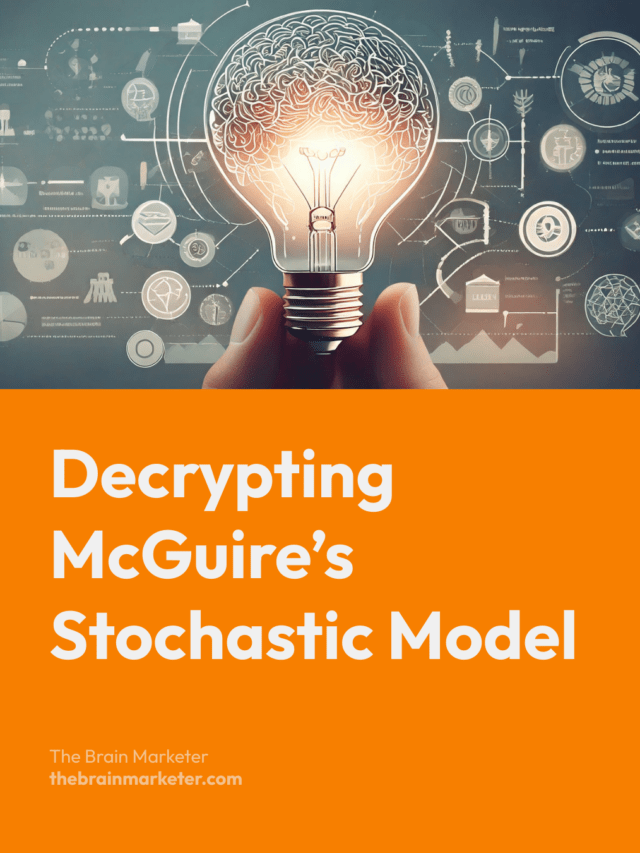Introduction
In the complex landscape of consumer behavior, understanding how individuals process advertising messages is crucial. McGuire’s Stochastic Model offers a structured framework that maps the stages a consumer goes through—from initial exposure to final action. By understanding these phases, marketers can design campaigns that truly resonate and drive meaningful behavior.
Key Takeaways
- Understand the six hurdles that shape every persuasion attempt—from attention to action
- Learn how to design campaigns that overcome message fatigue and information overload
- Discover why message clarity and emotional resonance are essential for memory retention
- Use credibility and context to build acceptance—even with skeptical audiences
- Apply stochastic thinking to anticipate variability in consumer behavior
🎙️ Unpack the Topic with this Podcast
What Is McGuire’s Stochastic Model?
McGuire’s model outlines a consumer’s progression through six probabilistic stages: exposure, attention, comprehension, acceptance, retention, and action. Each stage is a filter, and each filter is influenced by unpredictable variables like mood, timing, and context. This makes the journey less of a straight line and more of a probability-based sequence—hence the term stochastic.

Stage 1 – Attention: Capturing the Consumer’s Focus
In today’s media-saturated world, attention is scarce and fleeting. Most ads barely register on the radar.
Examples:
- A TV ad flickers while someone scrolls through Instagram.
- A billboard is seen in passing but quickly forgotten.
Marketing strategy: Disrupt the autopilot. Use surprise, contrast, or emotion to jolt the brain out of its routine and trigger attention.
Key Insight: Attention isn’t passive—it must be actively earned by challenging expectations.
Stage 2 – Comprehension: Making the Message Clear
Once you’ve caught someone’s attention, the next challenge is clarity. If the message is too abstract or complex, it won’t stick.
Examples:
- A visually stunning perfume ad that says nothing about the product.
- A fintech ad filled with technical jargon.
Marketing strategy: Combine creativity with familiarity. Use clear visuals, relatable metaphors, and concise copy.
Key Insight: As A. Moles (1970) suggested, effective advertising balances novelty with intelligibility.ing should strike a “happy compromise between novelty and intelligibility” to be both engaging and effective.
Stage 3 – Acceptance: Gaining Agreement
Understanding doesn’t equal agreement. Consumers evaluate whether the message aligns with their beliefs and values.
Challenges:
- Skepticism due to negative past experiences
- A disconnect between brand tone and consumer identity
Marketing strategy: Build trust through social proof, credible endorsements, and consistent brand values.
Key Insight: People buy meaning and identity—not just products. Speak their language.
Stage 4 – Retention: Making It Stick
If a message isn’t remembered, it can’t influence future behavior. Memory encoding is key.
Techniques:
- Repeat exposure
- Emotional resonance
- Mnemonic devices (e.g., slogans, jingles)
Marketing strategy: Use distinctive assets and emotional triggers to create lasting impressions.
Key Insight: Memorable messages shape future choices. Design to be recalled.
Stage 5 – Action: Driving Behavior
All prior stages must culminate in action—otherwise, the campaign fails. But action is often blocked by friction or distraction.
Barriers:
- Complex purchase processes
- Lack of urgency
- Competing offers
Marketing strategy: Reduce friction, create urgency, and highlight what’s at stake if the consumer doesn’t act.
Key Insight: Make action simple and rewarding. Remove the resistance.ht: Reducing barriers to action and creating a sense of urgency can significantly enhance conversion rates.
What Is a Stochastic Process?
A stochastic process refers to the random progression of a variable over time. In McGuire’s model, each stage of the process—attention, comprehension, acceptance, memorization, and action—can be seen as a random variable that depends on the consumer’s environment, mood, and personal context. This randomness makes it crucial for marketers to account for variability in how consumers will react to and engage with marketing messages.
Example: Different consumers may respond to the same ad in different ways, depending on their background, current situation, or prior experiences. Marketers must be aware of these variables and design their campaigns to increase the likelihood of success at each stage.
Why “Stochastic” Matters
In mathematics, a stochastic process is one governed by probability, not certainty. That’s exactly what McGuire’s model reflects. Consumer behavior is never guaranteed—it’s probabilistic.
Examples:
- Two people see the same ad. One converts, the other ignores it.
- Context, mood, and timing shape different outcomes.
Marketing strategy: Don’t seek perfection—optimize for probability. Improve your odds at every stage.
Key Insight: You can’t control the outcome, but you can influence the likelihood.
Conclusion
McGuire’s Stochastic Model offers a step-by-step framework to decode the consumer persuasion process. By understanding the stages of attention, comprehension, acceptance, retention, and action, marketers can create campaigns that resonate deeply with their audience.
The power of the McGuire’s Stochastic Model lies in its ability to break down complex consumer interactions into manageable steps. By addressing each stage thoughtfully, marketers can design more effective campaigns that guide consumers seamlessly from awareness to action.
Ultimately, persuasion isn’t about manipulation—it’s about fostering connections, providing value, and aligning your brand’s message with the needs and aspirations of your audience.
Sources
- McGuire, W. J. (1969). The Nature of Attitudes and Attitude Change. In G. Lindzey & E. Aronson (Eds.), The Handbook of Social Psychology
- Moles, A. (1970). Théorie des messages publicitaires
- Kahneman, D. (2011). Thinking, Fast and Slow
- Heath, C. & Heath, D. (2007). Made to Stick: Why Some Ideas Survive and Others Die
- Nielsen Norman Group – “The Value of Surprise in User Experience” (link)
- HubSpot – “How to Make Your Ads More Memorable” (link)

Vincent Heimann is a marketing project manager and neuromarketing enthusiast. He founded The Brain Marketer to bridge neuroscience and marketing through accessible, science-based content. With over 10 years of experience in digital strategy, UX/UI and communication, he shares practical insights to help brands connect with the human brain — ethically and effectively

